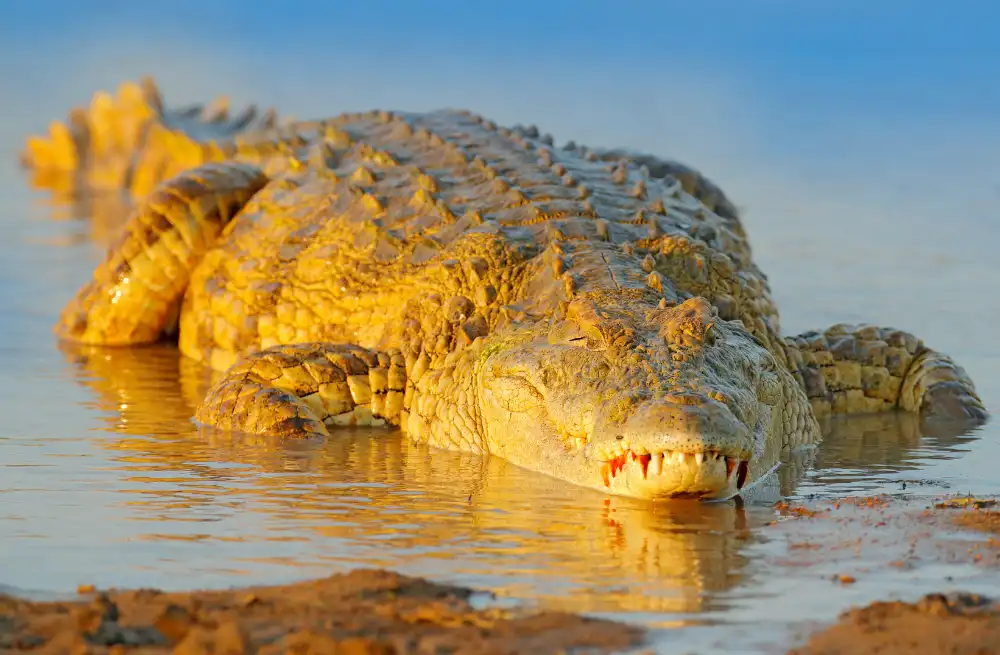Goblin sharks, also known as the “living fossil” sharks, are one of the most mysterious and intriguing creatures of the deep sea.
These unique sharks have a distinctive appearance and remarkable features that have fascinated scientists and marine enthusiasts alike.
From their elongated snouts to their protruding jaws, goblin sharks possess some of the most unique adaptations for hunting in the depths of the ocean.
In this article, we will delve into the fascinating world of goblin sharks and uncover what makes them so special. Join us as we explore the mysteries of the “living fossil” shark.
Goblin Shark Facts and Information
| Scientific Name | Mitsukurina owstoni |
| Family | Mitsukurinidae |
| Type | Fish |
| Order | Lamniformes |
| Temperament | Not aggressive towards humans |
| Lifespan | Up to 60 years |
| Size | 3.8 to 4.2 meters (12.5 to 14 feet) |
| Weight | Up to 200 kg (440 lb) |
| Diet | Carnivore, feeds on deep-sea creatures such as fish and cephalopods |
| Distribution | Found in deep waters worldwide |
| Habitat | Deep sea, typically found at depths of 100 to 1,000 meters (330 to 3,280 ft) |
| Other names | None |
Have you ever heard of the Goblin Shark?
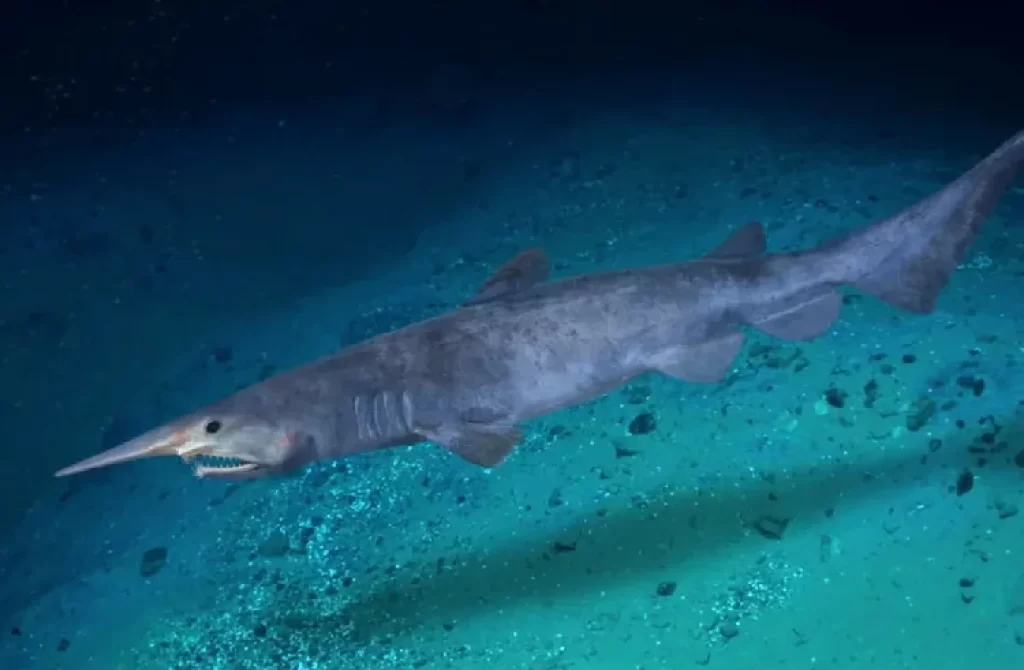
The Goblin Shark is a highly unique species of shark that isn’t commonly found in nature. However, it is a creature that attracts a lot of attention and curiosity from many people.
In this article, you will learn about the key characteristics of this peculiar species.
Discover the lifestyle of the Goblin Shark, how it hunts, reproduces, and what it feeds on. You will also understand why it is referred to as a “living fossil” and the only living species in the Mitsukurinidae family.
Furthermore, this article contains many fascinating facts that you may not know about the Goblin Shark.
For instance, did you know that the Goblin Shark doesn’t swim at high speeds? Come and explore more about this incredible creature!
Characteristic of the Globin Shark
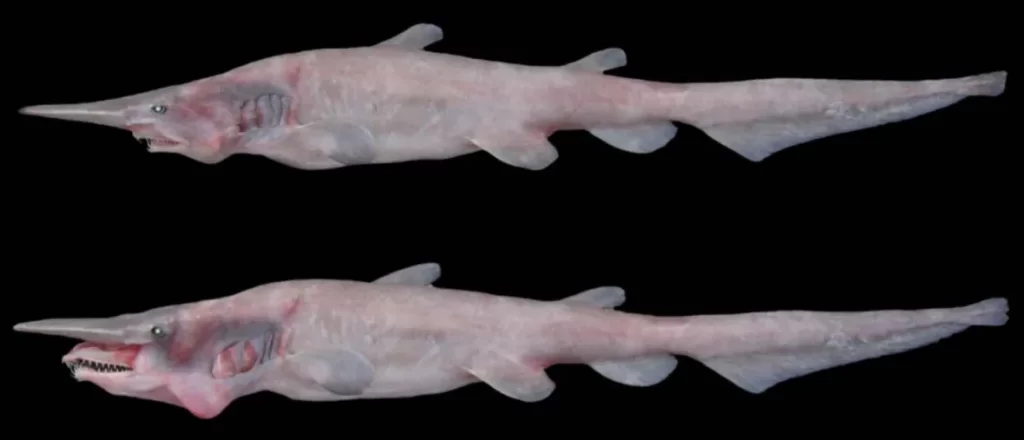
The Goblin Shark is a truly remarkable and unparalleled species that sets it apart from any other shark you may have seen before.
This section of the article will provide you with a comprehensive understanding of this extraordinary creature.
You will discover the fascinating origins of its name, learn about its distinctive physical characteristics, and delve into a wealth of other intriguing information that will captivate your interest.
Name and Origin
The Goblin Shark, also known as the Goblin or Elfin Shark, is found in a wide range of the Atlantic, Pacific, and Indian Oceans, but it is most commonly sighted along the coast of Japan.
Japanese fishermen who accidentally caught these sharks couldn’t help but notice their protruding snouts, which reminded them of popular stories about a long-nosed, red-faced demon known as Tengu.
As a result, they started calling the species “tengu-zame” (“zame” means “shark” in Japanese). This was later translated into English as “Goblin Shark,” with “Elfin Shark” being an alternative name occasionally used for this fascinating creature.
Visual Characteristics
The most distinctive feature of the Goblin Shark is its long, flattened snout that resembles the blade of a broad sword. This unusual feature has fascinated marine biologists for years, and there are many theories about its purpose.
Some believe that the elongated snout is used to search for food in narrow crevices, while others think it may be used to detect weak electrical fields in the water, similar to how a hammerhead shark’s unique head shape allows it to sense its prey.
The Goblin Shark’s jaws are attached to elastic ligaments, and when a potential meal approaches, the jaws protrude, allowing the shark to extend its entire mouth forward to a distance equal to 8.6 to 9.4 percent of its total body length.
This extraordinary ability is necessary because the shark’s long snout makes it difficult to bite prey directly in front of it. Instead, the Goblin Shark relies on its extended jaws to snatch up its food from a distance.
The upper jaw contains between 35 and 53 rows of teeth, and the lower jaw has 31 to 62 rows of teeth. The teeth are thin and pointed, designed to pierce and hold onto slippery prey like fish and squid.
They are replaced continuously throughout the shark’s life, with new teeth growing in at the back of the jaw and moving forward as the old teeth are lost.
This means that the Goblin Shark always has a fresh supply of sharp teeth ready to help it hunt and feed.
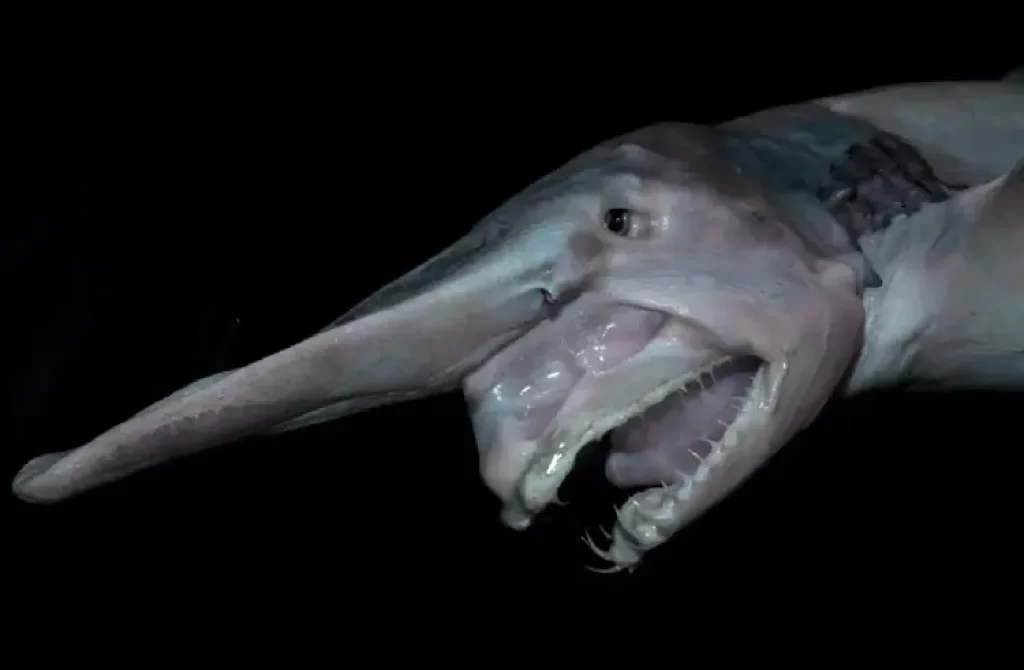
In addition to its unique snout and jaws, the Goblin Shark’s body is also distinctive. It has a long, slender body that is usually pinkish-gray in color, with a white underbelly.
Its skin is covered in small, tooth-like scales that give it a rough texture, similar to sandpaper. These scales are believed to offer some protection against predators and may also help to reduce drag as the shark swims through the water.
The Goblin Shark’s visual characteristics make it one of the most fascinating and enigmatic creatures in the ocean.
Its long snout, protruding jaws, and tooth-like scales are just a few of the many adaptations that allow it to thrive in its deep-sea habitat.
What makes the goblin shark unique?
The goblin shark is unique because of its distinctive appearance, as well as its ability to live in deep waters and its use of an electro-sensitive organ to capture prey.
Size, weight and lifetime of the Goblin Shark
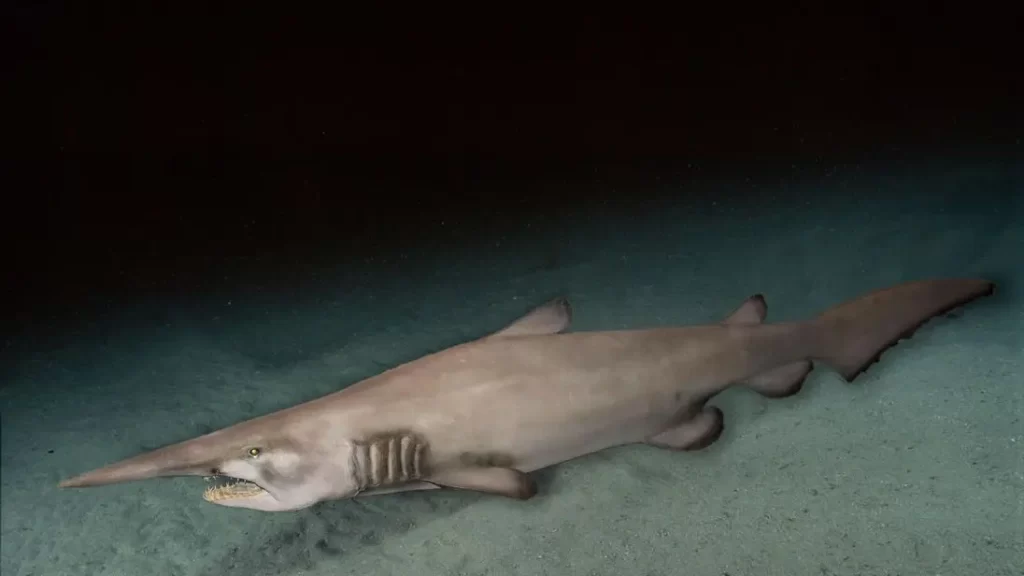
The Goblin Shark is known for its unique physical characteristics, but it is also noteworthy for its size and lifespan. Let’s take a closer look at these aspects of this fascinating species.
When Goblin Sharks are born, they typically measure between 80 to 100 centimeters in length. However, as they grow, their size increases significantly.
Mature males typically measure between 260 to 380 centimeters in length, while females are typically larger, measuring over 420 centimeters. Some colossal specimens measuring up to 620 centimeters have also been discovered.
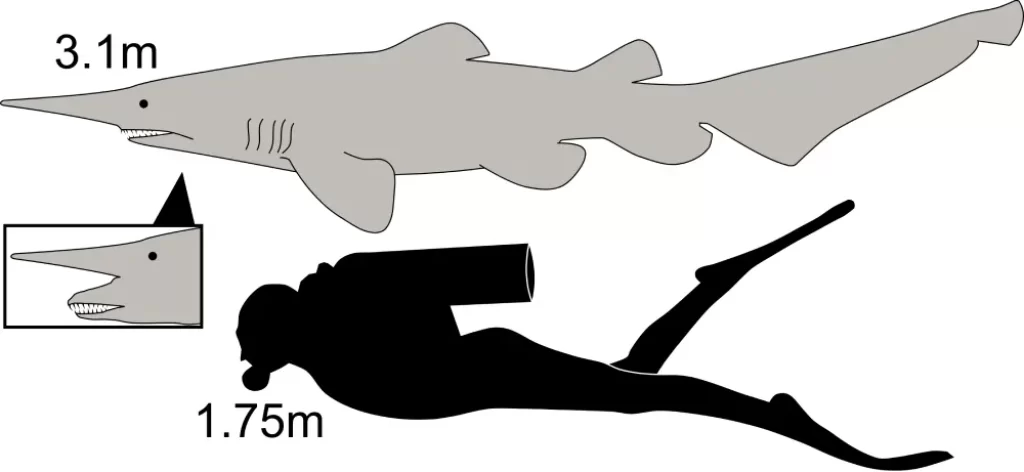
In terms of weight, Goblin Sharks can vary from 190 to 200 kilograms. The largest recorded specimen measured 3.6 meters in length and weighed 210 kilograms, but it is possible that these sharks can grow even larger.
As for their lifespan, Goblin Sharks have a relatively long life compared to other shark species. They typically live between 30 to 60 years, which is longer than some other shark species.
This long lifespan may be due in part to their unique adaptations, such as their ability to detect prey with their specialized rostrum and jaws.
Feeding habits of the Goblin Shark
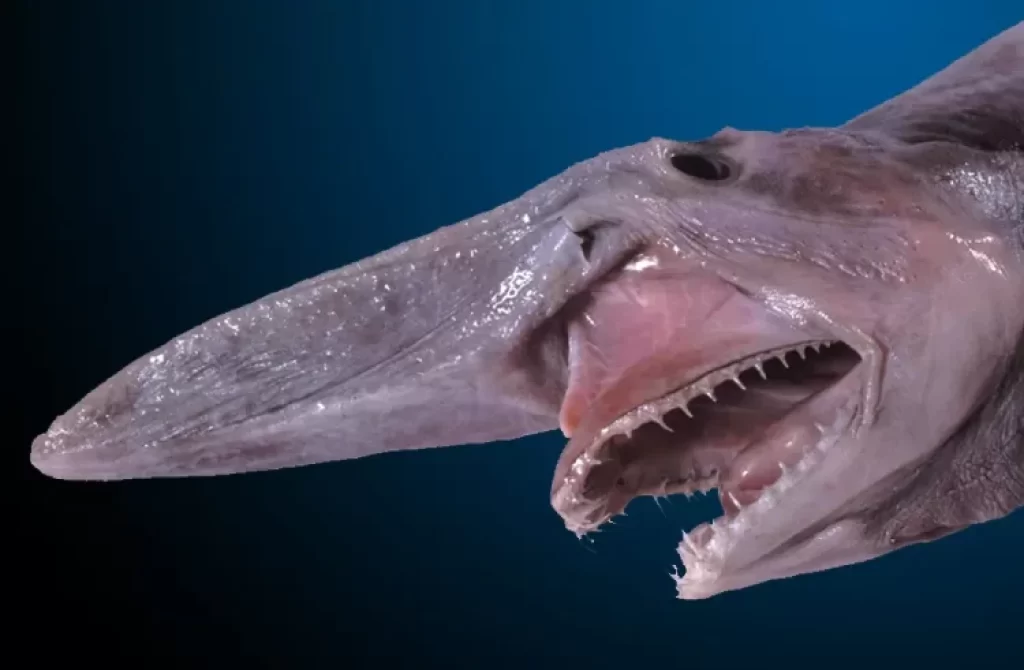
The Goblin Shark primarily feeds on crustaceans, plankton, copepods, fish eggs, squids, and bony fish. Occasionally, it also preys on octopuses, shrimps, and rays.
The Goblin Shark has developed an ambush hunting method, where it can silently approach its prey without making any sudden movements that might alert the prey.
Once the Goblin Shark’s target is within range, its uniquely positioned jaws can lunge forward, capturing unsuspecting fish or other marine life.
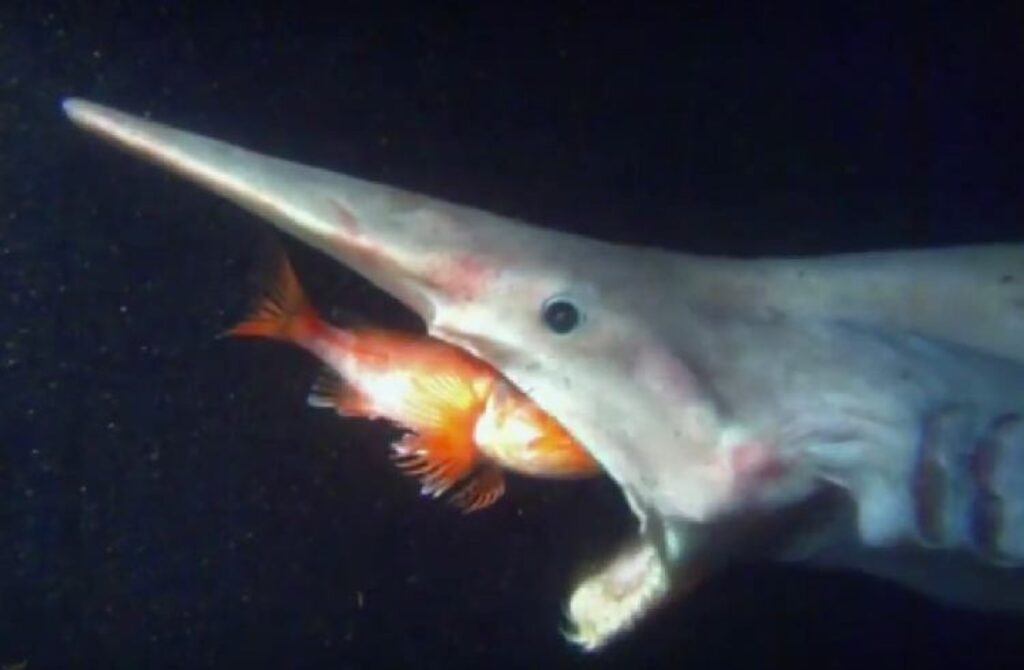
This hunting strategy is often described as predatory ambush. Despite its unusual appearance and hunting behavior, the Goblin Shark is not considered a threat to humans and is rarely encountered by divers or swimmers.
Exploring the Habitat and Distribution of the Goblin Shark
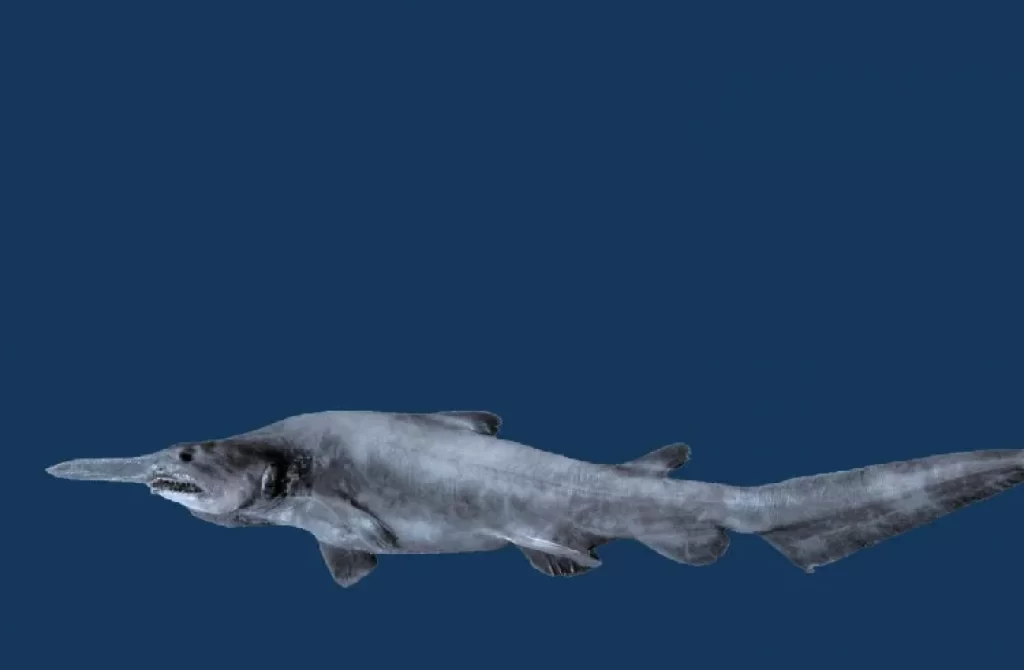
The Goblin Shark is primarily found in open ocean, residing in depths ranging from 330 to 4,300 feet (100 to 1,300 meters). Its distribution is sporadic and irregular throughout the Atlantic, Pacific, and Indian oceans.
The shark has been observed in the seas around Japan, New Zealand, France, Madeira, South Africa, Brazil, and several other countries.
Although it is primarily a deep-water species, there is some evidence to suggest that the Goblin Shark may occasionally venture into shallower waters, much like other deep-sea creatures.
This movement is often in search of prey, as the shark is known to feed on crustaceans, plankton, copepods, fish eggs, squids, and bony fish, as well as occasionally preying on octopuses, shrimps, and rays.
Fun fact: The elongated snout of the Goblin Shark is not only an efficient tool for finding food, but also has a unique sensory system that can detect the electric fields of its prey.
Where is the goblin shark found?
The Goblin Shark is primarily found in open ocean, residing in depths ranging from 330 to 4,300 feet (100 to 1,300 meters). Its distribution is sporadic and irregular throughout the Atlantic, Pacific, and Indian oceans.
For those using the imperial system, the Goblin Shark inhabits waters ranging from 1,100 to 14,100 feet in depth.
While it is primarily a deep-water species, there is some evidence to suggest that the Goblin Shark may occasionally venture into shallower waters, much like other deep-sea creatures.
This movement is often in search of prey, as the shark is known to feed on crustaceans, plankton, copepods, fish eggs, squids, and bony fish, as well as occasionally preying on octopuses, shrimps, and rays.
How rare is it to find a goblin shark?
The goblin shark is considered a rare species to encounter due to its deep-sea habitat and sporadic distribution.
They are not commonly caught by fishermen, and sightings of the shark in the wild are infrequent. Therefore, it is difficult to estimate the population size of this species.
However, with the advancements in technology and deep-sea exploration, scientists are beginning to learn more about this mysterious shark.
Behavior
Little is known about the behavior of this peculiar species. However, as we saw in the previous section, the goblin shark lives at great depths, and due to the absence of light in the deep waters where it swims, it detects the presence of prey through electro-sensitive organs located on its face or snout.
Once it finds its prey, the goblin shark protrudes its jaws and uses a tongue muscle to hold and pull the prey towards its sharp front teeth.
This hunting technique is often described as an ambush predator, where the shark silently attacks its prey without making many movements that could alert it of its approach.
The goblin shark may occasionally move into shallower waters when in search of prey, but little is known about its overall behavior and social interaction
Reproduction of the Goblin Shark
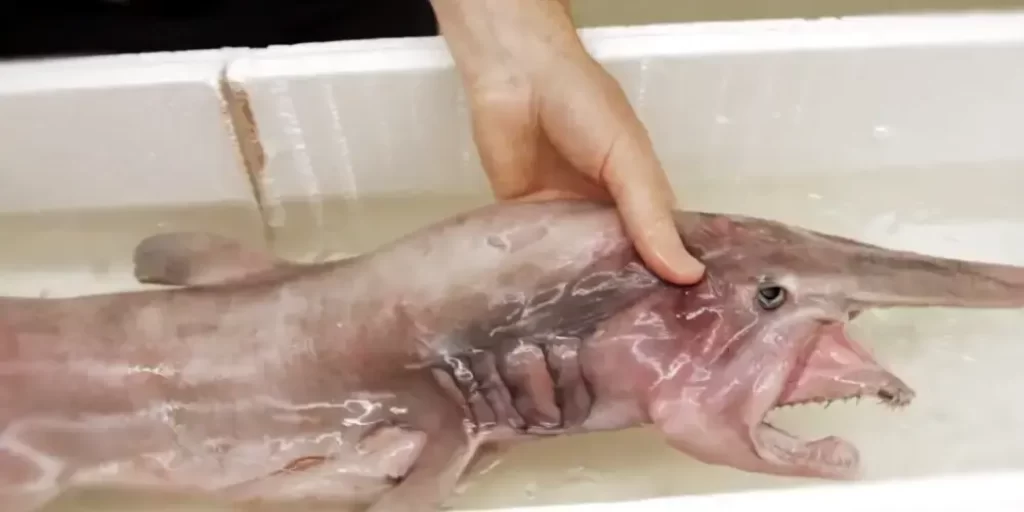
There is limited research on Goblin Shark reproduction, but it is believed that they are ovoviviparous and have a habit of migrating to mate and give birth.
Reproduction occurs through internal fertilization, where the male introduces the male reproductive organ (called the clasper) into the female reproductive tract (oviduct).
The eggs develop within the female’s oviduct, and when the embryos are fully developed, they are expelled.
The average size of a newborn Goblin Shark is believed to be around 2.7 feet (81 centimeters) in length. Male Goblin Sharks typically reach sexual maturity when they grow to a length just over 8 feet (2.5 meters).
Why the Goblin Shark is Considered a Living Fossil
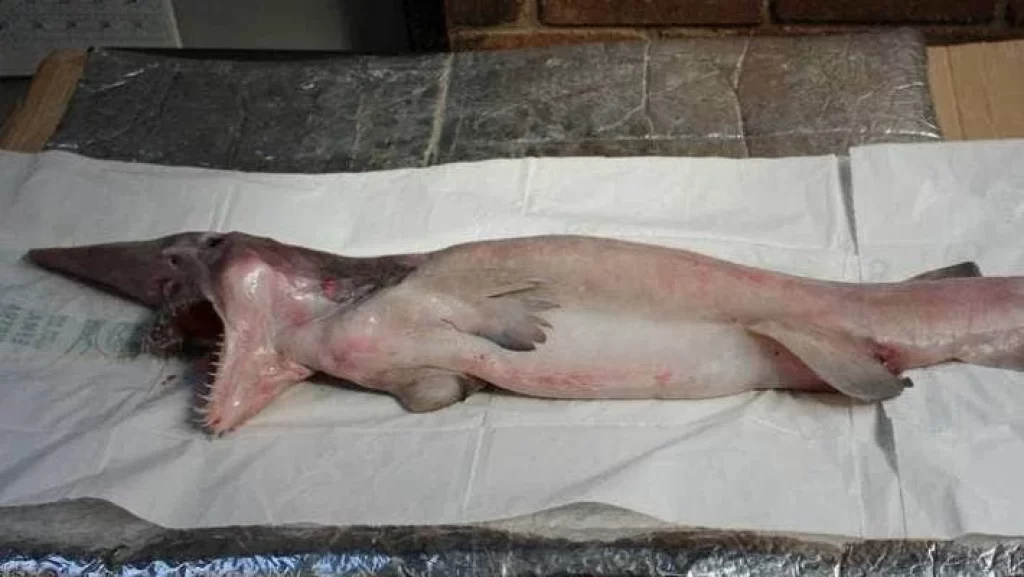
The Goblin Shark is far older than you might imagine and is one of the most ancient living animal species. But why is it considered a living fossil?
The Goblin Shark is millions of years old
The Goblin Shark is not your average shark species. It is a fascinating creature that has been deemed a “living fossil” due to its unique characteristics and ancient lineage.
It is the only living representative of the family Mitsukurinidae, a lineage of sharks that dates back 125 million years.
The Goblin Shark shares many similarities with the prehistoric shark species Scapanorhynchus, which lived during the Cretaceous period over 65 million years ago.
However, the relationship between the two species has never been proven, so it is unclear whether they are truly related.
Despite being around for millions of years, the Goblin Shark remains a mystery to researchers.
There is still much to be learned about this elusive deep-sea predator, making it a subject of ongoing fascination and study in the scientific community.
The Goblin Shark is the Only Living Species of the Mitsukurinidae Family
The Goblin Shark is the only living representative of the Mitsukurinidae family, which likely evolved during the Cretaceous period.
Sharks in this group – including the existing Goblin Shark – had thin needle-like teeth in the front of their mouths.
Prehistoric varieties included the Anomotodon novus, which lived in Europe and North America between 47.8 and 38 million years ago. Other fossil species had a global distribution.
The Mitsukurinidae family is part of an order of sharks known as Lamniformes, which also contains the Basking Shark and the Great White Shark. Lamniformes have five gill slits on each side of the body and most species have two dorsal fins.
The Goblin Shark’s evolution is a topic of great curiosity
Phylogenetic studies based on morphology classify the Goblin Shark as the most basal member of the Lamniformes order, also known as mackerel sharks.
Genetic data studies have also confirmed this basal classification for this species.
The Mitsukurinidae family is represented by the species Mitsukurina, Scapanorhynchus, and Anomotodon, all of which are Cretaceous period species.
Mitsukurina itself first appears in the fossil record during the Middle Eocene; extinct species include M. lineata and M. maslinensis.
Being the last member of an ancient lineage, and maintaining several “primitive” traits, the Goblin Shark has been described as a “living fossil”.
What sharks is considered a living fossil?
Sharks have been swimming in our oceans for millions of years, adapting and evolving to survive changing environments.
Some shark species have even been dubbed “living fossils” due to their ancient lineage and minimal changes over time. These unique sharks offer a glimpse into the past and a better understanding of the evolution of marine life
Here is a list of sharks that are considered living fossils:
- Goblin Shark (Mitsukurinidae family)
- Frilled Shark (Chlamydoselachidae family)
- Cow Shark (Hexanchidae family)
- Sixgill Shark (Hexanchidae family)
- Port Jackson Shark (Heterodontidae family)
What does a goblin shark do?
Like all sharks, the goblin shark is a predator that hunts for prey. It uses its long snout and electroreceptors to locate potential prey in the dark depths of the ocean.
When it detects a suitable target, it will quickly project its jaws forward to capture and bite its prey.
The goblin shark primarily feeds on deep-sea fish and cephalopods such as squid, but it has also been known to eat crustaceans and other sharks.
Outside of hunting and feeding, not much is known about the behavior of goblin sharks, as they are rarely encountered by humans due to their deep-sea habitat.
Goblin Shark: Fascinating Facts and Trivia
Let’s delve into some more fascinating facts about the Goblin Shark. Due to its unique and mysterious lifestyle, the Goblin Shark has piqued the curiosity of many people. Check out the following intriguing facts about this remarkable shark.
Goblin sharks use a unique feeding mechanism called ‘slingshot feeding’ to capture prey
The goblin shark has a remarkable hunting technique known as “slingshot feeding.” Its jaws are connected to elastic ligaments, and when the prey comes within striking range, the shark thrusts its jaw forward, allowing its whole mouth to catapult at a distance equivalent to 8.6 to 9.4 percent of its total body length.
To put it into perspective, if humans had this ability, we could bite into food that’s dangling 7 inches away from our nose. Hokkaido University researchers coined the term “slingshot feeding” to describe this unique bite style of the goblin shark.
The Conservation Status of Goblin Shark is Unknown
Although Goblin Sharks are rarely caught, they are believed to be common. Their rarity is likely due to the fact that they inhabit deep waters and are rarely seen near the surface.
Most of them are found on continental slopes between 100 and 1,130 meters deep.
Therefore, they have minimal interactions with human fishing activity, and it is uncommon for fishermen to encounter these sharks.
When they are caught, it often becomes local news. They are listed as “Least Concern” by the International Union for Conservation of Nature (IUCN) due to their unknown conservation status.
The Goblin Shark Shrinks as It Ages
An interesting fact about the Goblin Shark is that it shrinks as it gets older. The long and flattened snout of the Goblin Shark actually decreases in length proportionally with age.
This curious case even resembles humans, who tend to become hunched and shrink in size as they age.
As the Goblin Shark gets older, hunting can also become more difficult due to the decrease in snout size, which is a major tool for capturing prey.
The Goblin Shark is not considered a threat to humans
The Goblin Shark is not considered a threat to humans as these creatures are deep-sea residents, with few species found in shallow waters.
However, the opposite is true as the International Union for Conservation of Nature (IUCN) lists the Goblin Shark as a species of Least Concern.
While this is a good sign, with the Goblin Shark’s habitat slowly filling up with more and more human debris, this could change.
The fishing of Goblin Sharks also contributes to this, as they have become valuable to collectors. The meat can be dried, salted, and the jaws are highly prized by many.
If you’re intrigued by Goblin Sharks and want to learn more interesting facts, check out our dedicated article: “15 Facts About Goblin Sharks.“
The goblin shark is Not a fast swimmer
Why do goblin sharks have such bizarre jaws? The answer likely has to do with how they swim. Goblin sharks are flabby, soft-bodied predators with small fins and a flexible tail that wasn’t designed for rapid bursts of propulsion, making them slow-moving fish.
So perhaps the slingshot feeding technique evolved as a way to help the slow carnivore catch prey in low-light conditions.
The goblin shark Inspired movie characters
The goblin shark has already inspired some characters for the movies, for example, Knifehead, a kaiju from Pacific Rim (2013), this character has a long, pointed snout that is a deliberate homage to the goblin shark.
According to Charlie Henley, visual effects supervisor on Alien: Covenant in 2017, he and his team drew inspiration from the goblin shark when designing the film’s white-skinned “neomorph,” which had a set of protruding jaws that it used to kill a traveler in the middle of the movie.
Goblin Shark’s FAQ
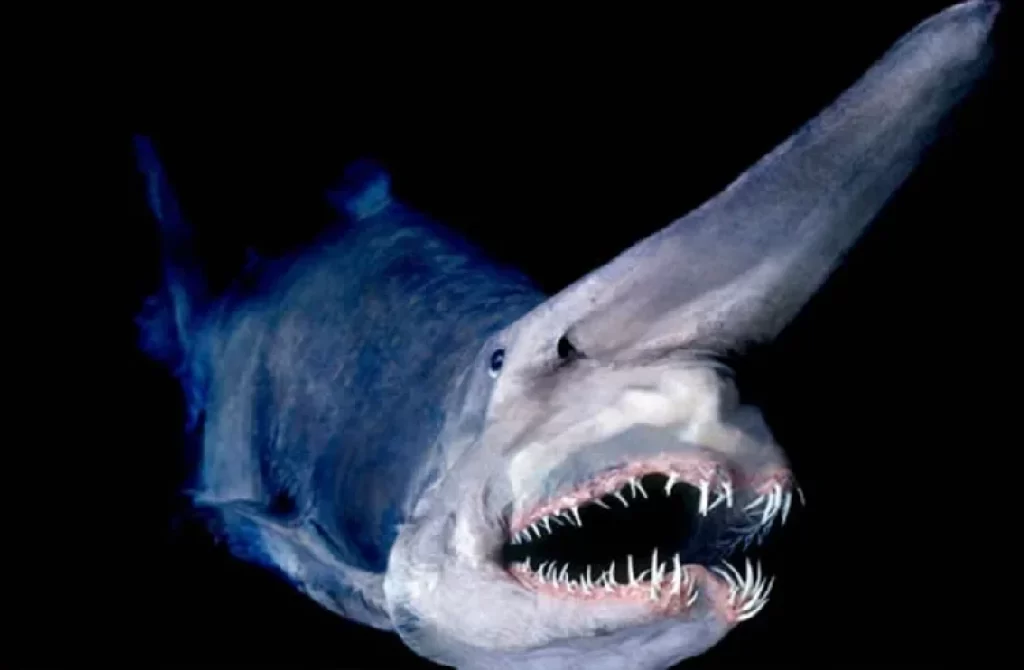
Why do goblin sharks look weird?
Goblin sharks have a distinct and unusual appearance due to their long protruding snouts and protrusible jaws.
These features help them capture prey in the deep-sea where they live. Their pinkish coloration is also unique and likely plays a role in their camouflage in their deep-sea habitat.
What are goblin sharks afraid of?
As deep-sea creatures, goblin sharks do not have any natural predators in their habitat. However, they are likely to avoid larger and more aggressive creatures such as orcas and other large sharks.
Can goblin sharks hurt humans?
There have been very few recorded interactions between goblin sharks and humans due to their deep-sea habitat.
However, like all sharks, goblin sharks are capable of biting if they feel threatened or provoked. It’s important to always exercise caution and respect when encountering any type of shark in the wild.
How fast can a goblin shark bite?
According to research, goblin sharks can project their jaws at speeds of up to 3.1 meters per second, which is the fastest speed recorded for a fish.
They can also protrude their jaws over distances comparable to 8.6-9.4 percent of the total length of their body, which is far beyond the jaw protrusion of other shark species.
Has a goblin shark ever attacked a human?
There have been no recorded instances of goblin sharks attacking humans, let alone fatal attacks. Goblin sharks typically live in deep waters and are not known to be aggressive towards humans. They primarily feed on deep-sea creatures such as fish and cephalopods.
The Goblin Shark – A Mysterious and Peculiar Species of Shark
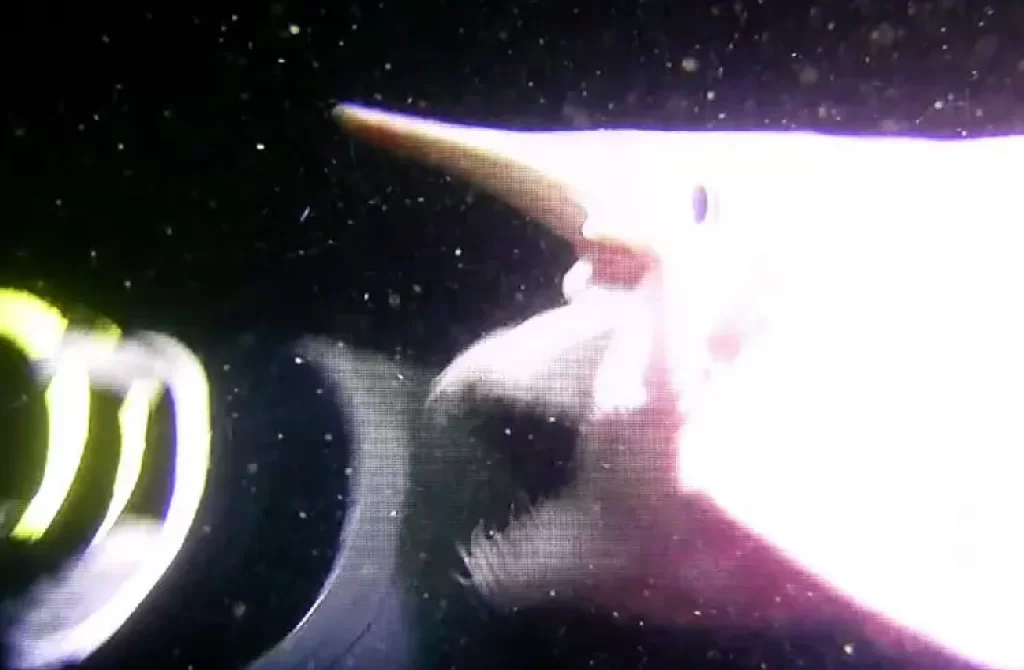
As we have seen, the goblin shark, also known as the “living fossil”, is a unique species of shark that has some fascinating characteristics.
One of the most notable features of the goblin shark is its elongated snout that can protrude and retract to capture prey. This unusual feature has led some to compare it to a swordfish or even a monster from a horror movie.
Living in the depths of the ocean, the goblin shark is rarely seen by humans. It is a deep-sea predator that prefers to inhabit waters that are more than 1000 meters deep.
This means that it is a difficult species to study, and there is still much to learn about its behavior, habitat, and life cycle.
Although it may be a rare sight for humans, the Goblin Shark continues to thrive in its habitat and plays a vital role in the ocean’s ecosystem.
As we continue to explore and discover the wonders of the ocean, we should remember the importance of protecting these incredible creatures and their environment.
Don’t forget to check out other articles about sharks and marine life on our website and share the content with your friends to raise awareness and appreciation for these amazing creatures.


